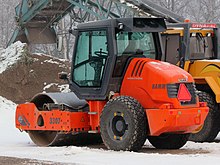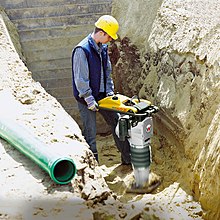Soil compaction
In
In
Before soils can be compacted in the field, some laboratory tests are required to determine their engineering properties. Among various properties, the maximum dry density and the optimum moisture content are vital and specify the required density to be compacted in the field.[2]




In construction
Soil compaction is a vital part of the construction process. It is used for support of structural entities such as building foundations, roadways, walkways, and earth retaining structures to name a few. For a given soil type certain properties may deem it more or less desirable to perform adequately for a particular circumstance. In general, the preselected soil should have adequate strength, be relatively
When an area is to be filled or backfilled the soil is placed in layers called lifts. The ability of the first fill layers to be properly compacted will depend on the condition of the natural material being covered. If unsuitable material is left in place and backfilled, it may compress over a long period under the weight of the earth fill, causing settlement cracks in the fill or in any structure supported by the fill.[4] In order to determine if the natural soil will support the first fill layers, an area can be proofrolled. Proofrolling consists of utilizing a piece of heavy construction equipment to roll across the fill site and watching for deflections to be revealed. These areas will be indicated by the development of rutting, pumping, or ground weaving.[5]
To ensure adequate soil compaction is achieved, project specifications will indicate the required soil density or degree of compaction that must be achieved. These specifications are generally recommended by a
The
Determination of adequate compaction is done by determining the in-situ density of the soil and comparing it to the maximum density determined by a laboratory test. The most commonly used laboratory test is called the Proctor compaction test and there are two different methods in obtaining the maximum density. They are the standard Proctor and modified Proctor tests; the modified Proctor is more commonly used. For small dams, the standard Proctor may still be the reference.[5]
While soil under structures and pavements needs to be compacted, it is important after construction to decompact areas to be landscaped so that vegetation can grow.
Compaction methods
There are several means of achieving compaction of a material. Some are more appropriate for soil compaction than others, while some techniques are only suitable for particular soils or soils in particular conditions. Some are more suited to compaction of non-soil materials such as asphalt. Generally, those that can apply significant amounts of shear as well as compressive stress, are most effective.
The available techniques can be classified as:
- Static – a large stress is slowly applied to the soil and then released.
- Impact – the stress is applied by dropping a large mass onto the surface of the soil.
- Vibrating – a stress is applied repeatedly and rapidly via a mechanically driven plate or hammer. Often combined with rolling compaction (see below).
- Gyrating – a static stress is applied and maintained in one direction while the soil is a subjected to a gyratory motion about the axis of static loading. Limited to laboratory applications.
- Rolling – a heavy cylinder is rolled over the surface of the soil. Commonly used on sports pitches. Roller-compactorsare often fitted with vibratory devices to enhance their effectiveness.
- Kneading – shear is applied by alternating movement in adjacent positions. An example, combined with rolling compaction, is the 'sheepsfoot' roller used in waste compaction at landfills.
The construction plant available to achieve compaction is extremely varied and is described elsewhere.
Test methods in laboratory
Soil compactors are used to perform test methods which cover laboratory compaction methods used to determine the relationship between molding water content and dry unit weight of soils. Soil placed as engineering fill is compacted to a dense state to obtain satisfactory engineering properties such as, shear strength, compressibility, or permeability. In addition, foundation soils are often compacted to improve their engineering properties. Laboratory compaction tests provide the basis for determining the percent compaction and molding water content needed to achieve the required engineering properties, and for controlling construction to assure that the required compaction and water contents are achieved. Test methods such as EN 13286-2, EN 13286-47, ASTM D698, ASTM D1557, AASHTO T99, AASHTO T180, AASHTO T193, BS 1377:4 provide soil compaction testing procedures.[7]
See also

References
- ^ Soil compaction due to lack of water in soil
- ISSN 0361-1981.
- ISBN 978-0-13-114560-3.
- ISBN 978-0-13-114560-3.
- ^ ISBN 978-0-13-114560-3.
- ISBN 0-534-38742-X.
- ^ "Automatic Soil Compactor". cooper.co.uk. Cooper Research Technology. Archived from the original on 27 August 2014. Retrieved 8 September 2014.

